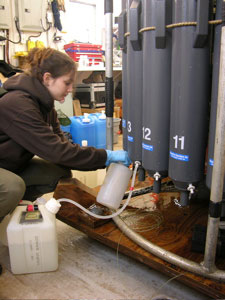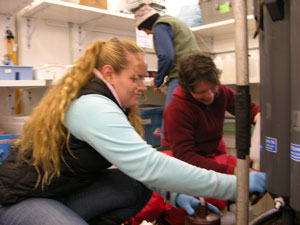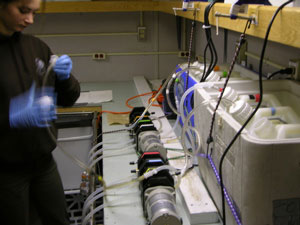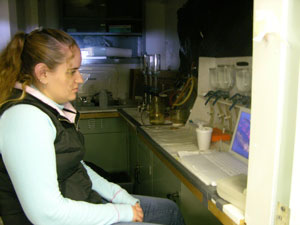Luc RainvilleAugust 11, 2007
When we think about life in the Arctic, we usually think of the rare polar bear, or the occasional seal (they saw two today while deploying the first ITP on a big ice flow near the northern tip of the Northwind Ridge), or maybe the small arctic cod that was spotted swimming around the rosette earlier in the cruise. It seems pretty thin. However, when you look closely (and I mean very closely, you might need a microscope!), there are tons of living organisms in the water column. We'll certainly talk about the tiny creatures we find in the bongo nets (zooplankton) in a future dispatch, but we should probably start at the base of the food chain, with the phytoplankton. Phytoplankton are floating plants that use the energy of the sun and nutrients present in the water to grow. These organisms fix atmospheric CO2 and therefore play a major role in marine ecosystems. Just like every other plant, chlorophyll is essential to this process. The diversity of the phytoplankton is what Karen Scracella and Émilie Didierjean, both from Université Laval, in Québec City, Canada, are interested in. Karen is working on her Master's with Dr. Connie Lovejoy - she will be using the data collected throughout this cruise - and Émilie volunteered to come on this cruise and help after spending a few months in Dr. Lovejoy's lab last year, to which she will likely return for graduate school. Their main goal is to extract the RNA and DNA (the genetic material of every living organism) from the water column to study the quantity and diversity of the Arctic ocean's phytoplankton. They also measure the amount of chlorophyll present at different depths of the water column, which gives a relative idea of the phytoplankton biomass. As with many other science projects happening on board, it's all about filtering. To get a sample for DNA (or RNA) analysis at a particular depth, Karen and Émilie collect 6 liters of water from one of the bottles of the CTD rosette, and make this water go through two filters: first a 3-micron filter, and 0.2-micron filter. Typically they do 6 depths for DNA, and 4 for RNA. Since the pores of the filters are so small, it takes 4-5 hours to filter all that water. The filters are then dried and saved for the analysis that will take place back at their university. They will isolate and then duplicate the genetic material, and finally sequence it. Once the sequence is known (the genetic code), the different species present can be identified. Karen is primarily interested in all the different types of diatoms (a group of unicellular eucaryotes within the phytoplankton), their position in the water column and spatial variability. A better understanding of the basis of the food chain is essential to get an handle on how the whole biological system works and how it might respond to changes. Last updated: October 7, 2019 | |||||||||||||||||||||||
Copyright ©2007 Woods Hole Oceanographic Institution, All Rights Reserved, Privacy Policy. | |||||||||||||||||||||||






